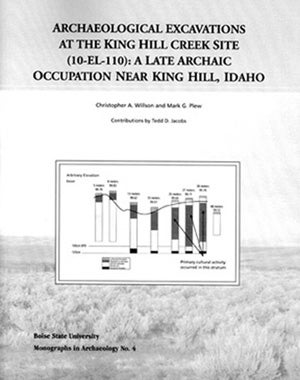
Monographs in Archaeology, Volume No. 4
by Christopher A. Willson and Mark G. Plew with contributions by Tedd D. Jacobs
ISBN: 978-0-9779515-1-2 (2007)
99 pp.
Cost $15.95
Purchase Archaeological Excavations at the King Hill Creek Site
Table of Contents
View Archaeological Excavations at the King Hill Creek Site Table of Contents (PDF)
List of Figures 111
List of Tables 1v
Acknowledgments v
Introduction
The Ethnographic Setting 2
Previous Archaeological Research 6
Environmental Setting 9
Field Methods 11
Stratigraphy 13
Formal Archaeological Features 15
Material Culture 16
- A. Projectile Points and Point fragments 16
- B. Utility tools 19
- C. Manufacturing 21
- D. Domestic 21
- E. Decorative 22
Functional Distribution of Artifacts 25
Geochemical Characterizations 26
Lithic Debitage Analysis 29
Thermally Altered Rock 30
Fauna! Remains 30
Fish Remains 32
Summary of Significant Findings and Implications 33
References Cited 37
Appendix I: Prehistoric Artifact Distribution 43
Appendix II:Ceramic Analysis 53
Appendix III: Distribution of Non-Artifactual Material, 10-EL-110 59
Appendix IV: Results of Particle Size Analysis of Sediments Collected from Site
1O-EL-1 I 0, Located on the Snake River, Idaho, by Tedd D. Jacobs 67
Appendix V: Results of X-Ray Fluorescence Analysis 97
Introduction
During May and June 2006, Boise State University conducted an archaeological field school located on property owned by Harry Knox and Pamela Swenson. The area selected for study lies on the southwestern edge of the River Ranch property approximately 1/4 miles west of King Hill, Idaho. The site proper is located on a terrace located on the north bank of the Snake River and is bordered by King Hill Creek to the southwest. Pre-excavation surveys of the site identified three activity areas each roughly 5-10 meters in diameter. Materials observed on the ground included lithic debris in various sizes and material types, mussel shell fragments, fire-cracked rock and miscellaneous formal tools as well as four small depressions associated with previous vandalism of the site. The western-most extension of the site is characterized by deflated surfaces and an area from which sediments were previously removed. These conditions may be associated with construction of the Union Pacific Railroad built in 1903 and running east-west along the northern boundary of the site.
A long-term research focus of Boise State anthropology has been the examination of Late Archaic sites along the Snake River. As a result, a number of sites have been excavated or tested along the river between Hagerman and Walter’s Ferry, Idaho (see e.g., Plew 1981; Gould and Plew 2001; Plew and Sayer 1995; Plew, Plager, Jacobs and Willson 2006). Within this reach of the Snake River, much work has focused on sites in areas near Bliss, King Hill, Glenns Ferry, and Hammett, Idaho (see e.g., Plew 1981; Gould and Plew 2001, 2003; Plew and Chavarria 1992; Plew, Huter, Benedict 2002; Plew and Willson 2007). These investigations have documented a range of prehistoric activities that include tool manufacture, toolstone acquisition, and animal processing and evidence of fishing and short-term storage. Recent investigations at the Knox site (10-EL-1577, Plew, Huter and Benedict 2007), located approximately one mile downstream from Clover Creek and only two hundred meters east of 10-EL-110, have documented extensive early stage basalt reduction and the use of large cooking hearths that appear to have been periodically cleaned out and reused. Assemblage variation at the Knox site reflects a foraging lifeway (see Kelly 2001; Gould and Plew 1996). Investigation of site 10-EL-110 provided an opportunity to further delineate the range of Late Archaic activities and to address other regional questions, particularly those relating to mobility and subsistence.
The excavation was guided by a research design that sought to address a number of specific historical and behavioral questions. We sought first to create a depositional history of the site that would inform us regarding the age and integrity of the deposits and determine temporal periods during occupations of the terrace occurred. We sought as well to evaluate the nature of subsistence and level of mobility of the groups occupying the area (see e.g. Gould and Plew 1996; Plew et al. 2006). Our methodological framework sought to jointly evaluate technological and zooarchaeological assemblage variability as the primary means by which we assessed mobility and optimality of resources within the diet breadth. In this regard one of the questions we sought to address is whether fishing constituted a more important contribution to the diet than large to medium and small mammals. More specifically, we sought to assess whether there was variance in strategies of toolstone acquisition that might corroborate the linear Snake River pattern of lithic distribution described by Holmer (1997) and Plager (2001) and whether ceramics would support the mobile forager thesis of Simms et al. (1997) or the mineralogical selection suggested by Dean and Horting (2000).